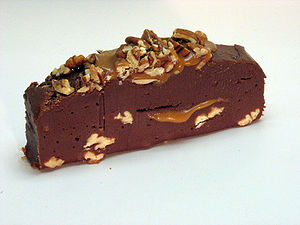Tag Archive: working with chocolate
Orange Zest Seized My Chocolate
July 22, 2010
Recently, I was asked this question: “I love the taste of chocolate and orange but when I add orange zest to my coating it curdles. Why?”
 This presents an excellent technical lesson in working with chocolate.
This presents an excellent technical lesson in working with chocolate.
The issue is moisture.
Read more
Hints for Molding Chocolate
May 10, 2010
This is the second part of the series. If you missed the first part, or you'd like a review, please see Tips for Molding Chocolate.
Now that you're caught up, here are my Extra Special Helpful Hints when working with chocolate molds.
Read more
Tips for Molding Chocolate
April 29, 2010
Molded Chocolate (not to be confused with moldy chocolate!), or chocolate from molds (moulds), has been around for a long time.
Most chocolate molds are made of either metal or plastic. They can be flat, to shape chocolate like a candy bar, or three dimensional, to shape like an Easter bunny.
If you are a beginner at working with chocolate, start with a flat plastic mold with small cavities of simple shapes. You can buy these at craft stores or baking/candy supply stores or online at a number of candy-making supply websites.
Read more
Troubleshoot Chocolate Tempering
February 18, 2010
Recently I was asked about tempered chocolate that fails to keep a good shine and what can be done to fix that? (See comments on how to temper chocolate page.)
That's a really good question. Concerns about the streaking and the lack of shine make me think about how temperatures, crystal development and the appearance of chocolate are all connected.
Properly tempered chocolate is shiny and uniform in color. When chocolate has streaks and does not shine, it indicates that at some point in the production process, the chocolate solidified without being in a properly tempered state.
Read more
Chocolate Covered Strawberries
February 2, 2010
Have you ever cut corners while cooking? Ever used short cuts that the original recipe had you make from scratch?
 I have. And why not? Most often those “changes” don’t affect the final product and it saves lots of time. Yes, sometimes I even buy frosting in a can (shhh, don’t tell my kids!).
I have. And why not? Most often those “changes” don’t affect the final product and it saves lots of time. Yes, sometimes I even buy frosting in a can (shhh, don’t tell my kids!).
One thing I have learned from my experience working with chocolate is that there are some short cuts that work and some that don’t.
Read more
Oh, Fudge!
December 9, 2009
Every year around Christmas time I attend at least one holiday cookie exchange party or dessert buffet event. Among the many traditional cookies there is always fudge.
 Fudge is a treat anytime of year, but for me, it is especially meaningful during the holidays.
Fudge is a treat anytime of year, but for me, it is especially meaningful during the holidays.
As a child, I remember my mother and grandmother walking around the house stirring, and stirring, and stirring that bowl of fudge. Sometime they would pause to watch TV, I suppose to prevent boredom, stirring all the while.
Read more
Avoid Mistakes While Tempering Chocolate
November 12, 2009
As a follow-up to a few recent posts about tempering chocolate, I thought it might be useful to discuss some common mistakes you might make when tempering.
The most common mistakes I see are the lack of temperature control, lack of proper stirring, not choosing the right chocolate for the job, improper storage, and letting moisture contact the chocolate.
Let’s take a closer look at each of these situations...
Read more
How to Temper Chocolate (Step 2 – Finish)
October 8, 2009
When you buy chocolate in the store, it is already tempered. (At least it should be!) Basically this means it is in a stable solid form at room temperature.
If you want to get down to the business of eating the chocolate straight out of the package, no problem, just break off a chunk and go to it! But, if you want to use the chocolate for any other purpose you may have to re-temper.
This is the final part in my series of tempering chocolate. The first article was about the importance of tempering chocolate. The last article was about melting the chocolate to get ready for tempering.
Read more
How to Temper Chocolate (Step 1 – Melt It)
September 14, 2009
The first step in tempering chocolate is melting the chocolate... Properly!
You might be thinking, what's the big deal about melting chocolate?
Chocolate is a low melting point food. It melts just below human body temperature. While this low melting point means it’s easy to melt in the mouth, it also means it’s easy to burn when direct heat is used. Overheating chocolate will cause it to burn. Burnt chocolate is irreversibly damaged and cannot be used.
In addition to burning, another potential problem when melting chocolate is "seizing". This can happen if you use an indirect heating method like a hot water and a double boiler. Small amounts of water will cause the chocolate to “seize” or become hard and crumbly. Seized chocolate is irreversibly damaged and cannot be used.
The Importance of Tempering Chocolate
August 31, 2009
I admit my mind works differently than that of other chocolate lovers. I am a scientist first, I guess, then a chocolate lover.
One day I was attending a local street festival and happened upon a vendor selling “Fresh Pineapple – Chocolate Covered!” Most people’s first reaction might be, “Yum!” but mine was more like, “Well, this is interesting. It is either a chocolate disaster in the making (there’s too much moisture in most fresh fruit to support a tempered chocolate) or a major discovery!”

